what shifts the supply curve to the right
vi.6 Shifts in Supply and Need Curves
In add-on to the factors that crusade fluctuations in the market equilibrium, some developments may atomic number 82 to sustained changes in the market equilibrium. For example, if a new product becomes available that is a viable substitute for an existing product, there is likely to be either a persistent drib in the quantity consumed of the existing good or a reduction in the market place price for the existing good.
The touch on of these persistent changes tin be viewed in the context of changes in the behavior of buyers or the operations of sellers that cause a shift in the demand bend or the supply curve, respectively. In the case of the new availability of a close substitute for an existing product, nosotros would expect the demand curve to shift to the left, indicating that at whatever market place price for the existing practiced, demand will be less than it was prior to introduction of the substitute. Equally another instance, consider the supply bend for gasoline after an increase in the cost of crude oil. Since the cost of producing a gallon of gasoline will increment, the marginal toll of gasoline will increase at any level of product and the upshot will be an upward shift in the supply bend.
It is oftentimes of involvement to determine the touch on of a changing cistron on the market equilibrium. Volition the equilibrium quantity increase or subtract? Will the equilibrium price increase or decrease? Volition the shift in the equilibrium point be more of a change in price or a change in quantity? The examination of the impact of a change on the equilibrium point is known in economics every bit comparative staticsThe examination of the impact of a alter on the equilibrium signal. .
In the case of a shifting demand curve, since the supply curve is generally upward sloping, a shift of the demand curve either upwardly or to the right will result in both a higher equilibrium price and equilibrium quantity. Likewise, a shift in the demand bend either downward or to the left will unremarkably result in a lower equilibrium price and a lower equilibrium quantity. Then in response to the introduction of a new substitute skillful where nosotros would expect a leftward shift in the demand bend, both the equilibrium price and quantity for the existing good can be expected to subtract (come across Effigy 6.five "Shift of Market Demand to the Left in Response to a New Substitute and Change in the Market place Equilibrium").
Whether a shift in the demand curve results in a greater relative change in the equilibrium toll or the equilibrium quantity depends on the shape of the supply curve. If the supply curve is fairly apartment, or elastic, the change will exist primarily in the equilibrium quantity (run into Figure vi.vi "Impact of Elasticity of the Supply Bend on the Touch of a Shift in the Need Curve"). An rubberband supply curve means that a modest change in toll typically results in a greater response in the provided quantity. If the supply curve is fairly vertical, or inelastic, the change in equilibrium will be mostly seen as a price change (see Figure 6.vii "Bear upon of Elasticity of the Supply Curve on the Impact of a Shift in the Demand Curve").
Figure half dozen.5 Shift of Market Demand to the Left in Response to a New Substitute and Change in the Marketplace Equilibrium
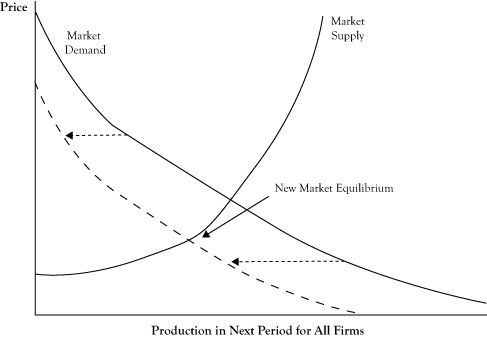
Figure 6.vi Impact of Elasticity of the Supply Curve on the Impact of a Shift in the Demand Bend
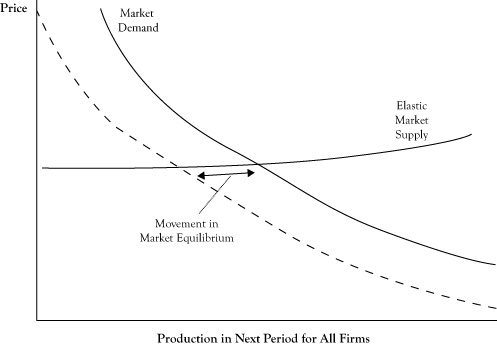
The shift is more often than not in terms of the quantity when the supply curve is elastic.
Figure 6.7 Affect of Elasticity of the Supply Bend on the Impact of a Shift in the Demand Curve
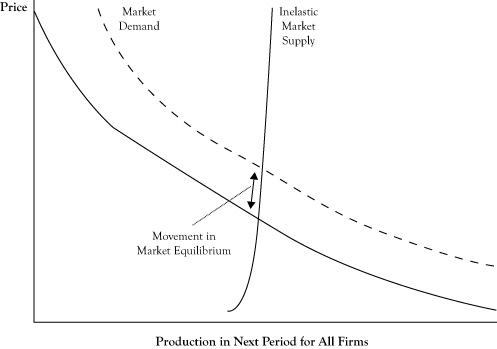
The shift is more often than not in terms of the cost when the supply curve is inelastic.
A shift in the supply curve has a unlike effect on the equilibrium. Because the demand bend is mostly downwards sloping, a shift in the supply bend either upwards or to the left volition result in a higher equilibrium price and a lower equilibrium quantity. However, a shift in the supply either downward or to the right will result in a lower equilibrium price and a higher equilibrium quantity. Then for the example of the gasoline market where the supply curve shifts upward, nosotros tin look prices to rise and the quantity sold to subtract (see Figure 6.8 "Shift of Marketplace Supply Upward in Response to an Increase in the Cost of Crude Oil and Alter in the Market Equilibrium").
The shape of the demand curve dictates whether a shift in the supply bend volition result in more than change in the equilibrium price or the equilibrium quantity. With a need curve that is flat, or elastic, a shift in supply curve will change the equilibrium quantity more than the price (see Figure half dozen.9 "Impact of Elasticity of the Demand Bend on the Impact of a Shift in the Supply Curve"). With a demand curve that is vertical, or inelastic, a shift in the supply bend will change the equilibrium price more than the equilibrium quantity (see Effigy six.10 "Touch of Elasticity of the Demand Curve on the Touch on of a Shift in the Supply Curve").
The characterization of a demand bend as existence rubberband or inelastic corresponds to the measure of price elasticity that was discussed in Affiliate 3 "Demand and Pricing". Remember from the give-and-take of short-run versus long-run need that in the short run, customers are limited in their options by their consumption patterns and technologies. This is particularly true in the case of gasoline consumption. Consequently, short-run demand curves for gasoline tend to be very inelastic. As a consequence, if changing crude oil prices results in an upward shift in the supply curve for gasoline, we should wait the result to be a substantial increment in the price of gasoline and only a fairly modest decrease in the corporeality of gasoline consumed.
Figure 6.eight Shift of Market Supply Up in Response to an Increase in the Toll of Crude Oil and Alter in the Marketplace Equilibrium
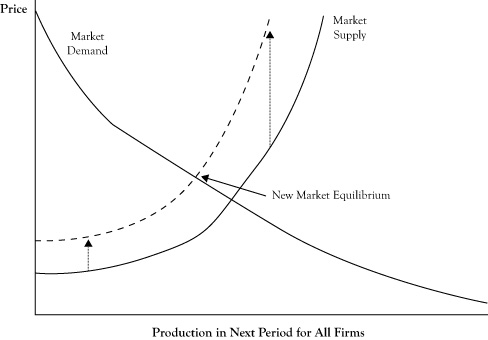
Effigy 6.9 Touch of Elasticity of the Demand Curve on the Impact of a Shift in the Supply Curve
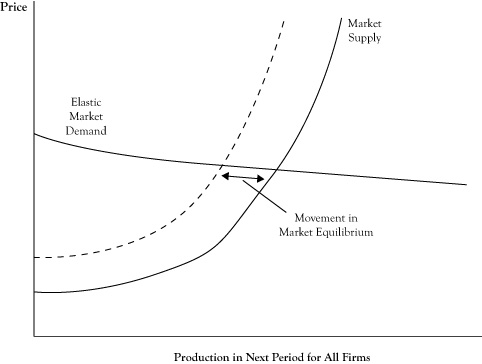
The shift is more often than not in terms of the quantity when the need curve is elastic.
Figure half dozen.ten Bear upon of Elasticity of the Demand Curve on the Bear on of a Shift in the Supply Bend
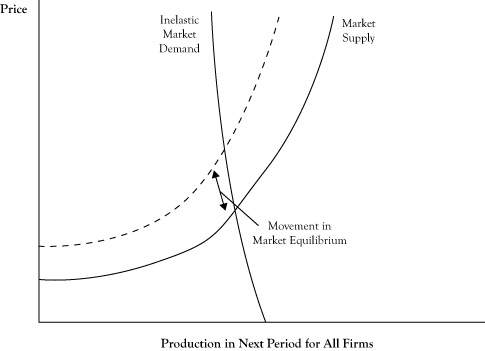
The shift is generally in terms of the price when the need bend is inelastic.
Source: https://saylordotorg.github.io/text_principles-of-managerial-economics/s06-06-shifts-in-supply-and-demand-cu.html
0 Response to "what shifts the supply curve to the right"
Post a Comment